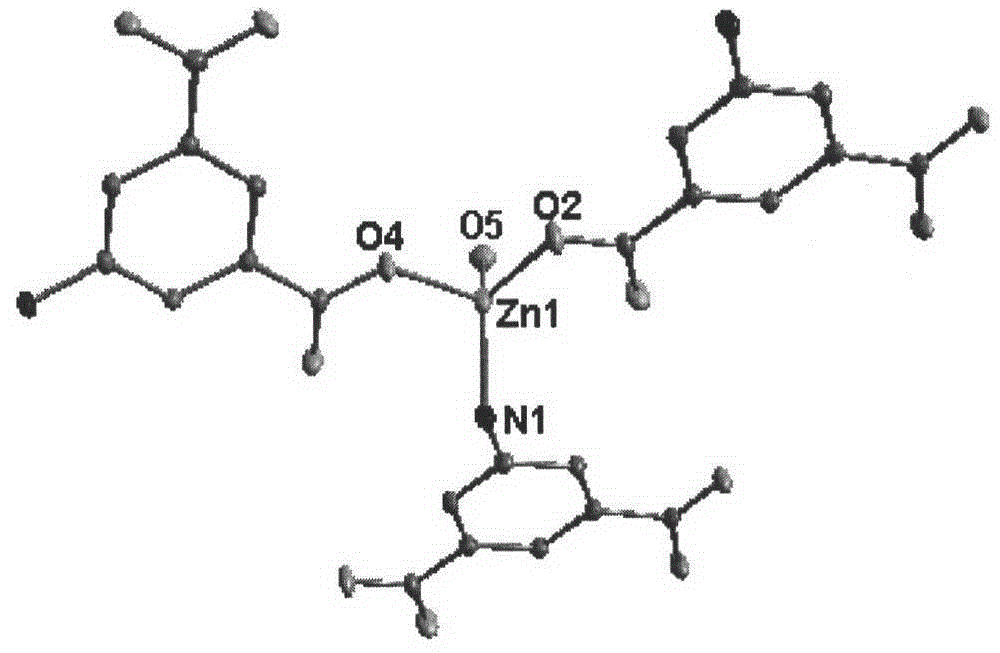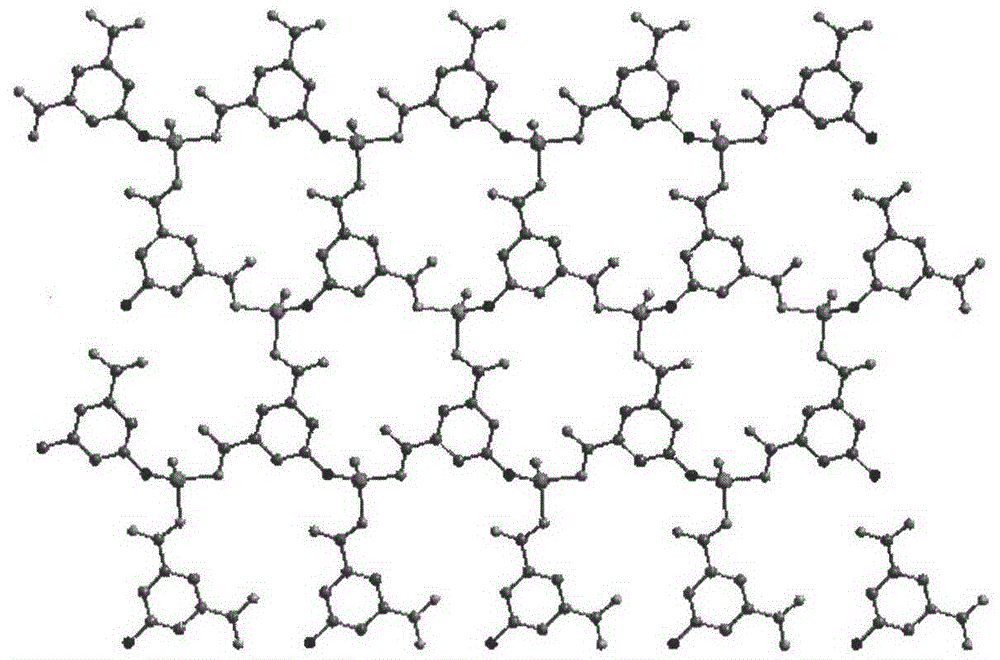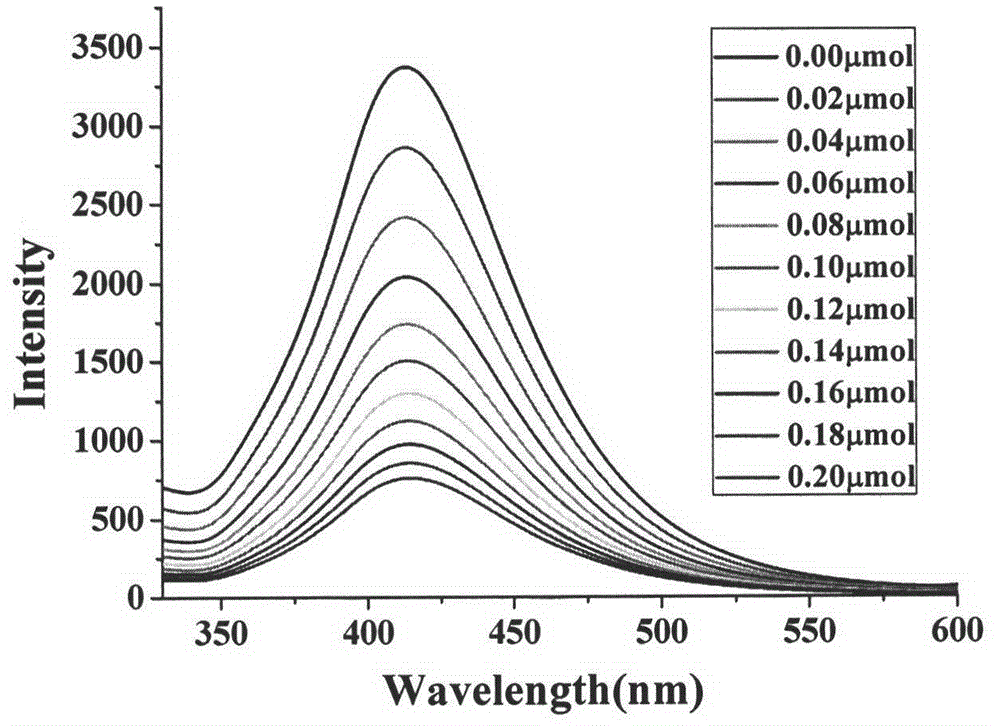Application of luminous metal organic framework material in detecting nitro aromatic hydrocarbon pollutant
A metal-organic framework, organic pollutant technology, applied in the preparation of luminescent materials, organic compounds, organic chemistry and other directions, can solve the problems of expensive equipment, bulky, low sensitivity, etc., achieve simple preparation methods, high material purity, Responsive effect
- Summary
- Abstract
- Description
- Claims
- Application Information
AI Technical Summary
Problems solved by technology
Method used
Image
Examples
Embodiment 1
[0025] The synthesis of embodiment 1 complex:
[0026] Zn(NO 3 ) 2 ·6H 2 A mixture of O (0.0298g, 0.05mmol), 5-aminoisophthalic acid (0.0091g, 0.05mmol), 4mL DMF and 4mL distilled water was placed in a polytetrafluoroethylene liner and reacted at a constant temperature of 85°C for 120 hours. Then naturally cooled to room temperature, filtered, the resulting product was washed with DMF, and dried at room temperature to obtain block crystals C 16 h 14 N 2 o 10 Zn 2 , Theoretical value (%): C, 36.57; H, 2.67; N, 5.33; Experimental value (%): C, 35.87; H, 2.29; N, 5.73. The crystal structure was determined using a BRUKER SMART 1000 X-ray diffractometer, using Mokα rays ( ) is the incident radiation, the diffraction points are collected by ω-2θ scanning, and the unit cell parameters are obtained through the least square method correction, and the crystal structure is obtained from the difference Fourier electron density map using the SHELXL-97 direct method, and the Lor...
Embodiment 2
[0027] Embodiment 2 (p-chloronitrobenzene sensing), process is as follows:
[0028] First measure the fluorescence intensity F of the sensing material in the absence of p-chloronitrobenzene 0 , then add the p-chloronitrobenzene (0 μmol, 0.02 μmol, 0.04 μmol, 0.06 μmol, 0.08 μmol, 0.10 μmol, 0.12 μmol, 0.14 μmol, 0.16 μmol, 0.18 μmol, 0.20 μmol) of the amount of gradient substance, and measure different substances The fluorescence intensity F of sensing material when the amount p-chloronitrobenzene exists, draw the curve of fluorescence intensity F changing with the amount of p-chloronitrobenzene substance, see image 3 , the test results show that the fluorescence intensity decreases gradually with the increasing amount of p-chloronitrobenzene; when the amount of p-chloronitrobenzene reaches 0.20μmol, the degree of fluorescence quenching reaches 77.51%.
Embodiment 3
[0029] Embodiment 3 (p-nitroaniline sensing), the process is as follows:
[0030] First measure the fluorescence intensity F of the sensing material in the absence of p-nitroaniline 0 , and then add the p-nitroaniline (0μmol, 0.02μmol, 0.04μmol, 0.06μmol, 0.08μmol, 0.10μmol, 0.12μmol, 0.14μmol, 0.16μmol, 0.18μmol) of the amount of gradient substance, and measure the amount of p-nitroaniline of different substances Fluorescence intensity F of the sensing material in the presence of p-nitroaniline, draw the curve of fluorescence intensity F varying with the amount of p-nitroaniline substance, see Figure 4 , the test results show that the fluorescence intensity decreases gradually with the increasing amount of p-nitroaniline substance; when the amount of p-nitroaniline substance added reaches 0.20μmol, the degree of fluorescence quenching reaches 53.39%.
PUM
 Login to View More
Login to View More Abstract
Description
Claims
Application Information
 Login to View More
Login to View More - R&D
- Intellectual Property
- Life Sciences
- Materials
- Tech Scout
- Unparalleled Data Quality
- Higher Quality Content
- 60% Fewer Hallucinations
Browse by: Latest US Patents, China's latest patents, Technical Efficacy Thesaurus, Application Domain, Technology Topic, Popular Technical Reports.
© 2025 PatSnap. All rights reserved.Legal|Privacy policy|Modern Slavery Act Transparency Statement|Sitemap|About US| Contact US: help@patsnap.com



